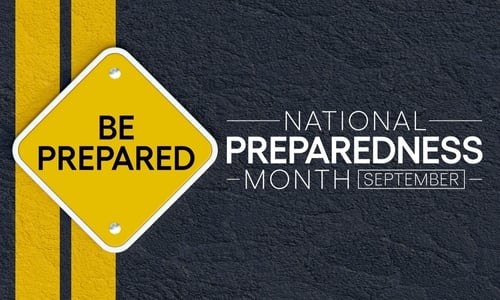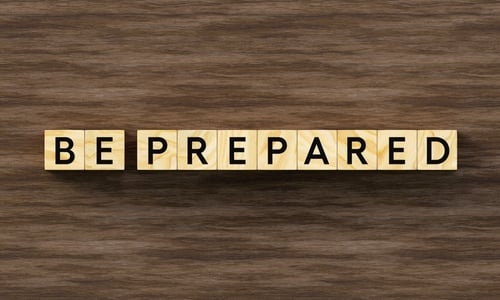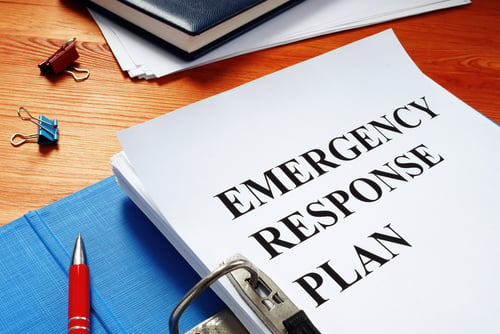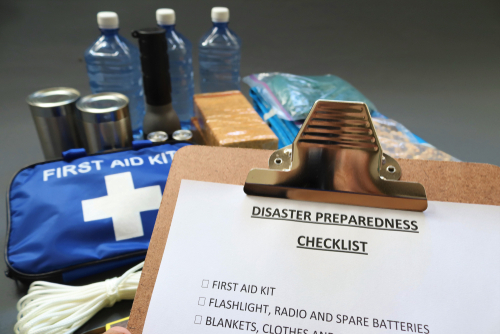Every September, the United States observes National Preparedness Month in order to educate citizens and prepare for disasters or emergency situations at home. Throughout September, businesses, homeowners, and communities can learn more about preparing for disasters and reducing health and environmental risks. Want to hear more about National Preparedness Month? Keep reading to learn how you can participate.

What Is National Preparedness Month?
National Preparedness Month starts on September 1st of every year to remind US citizens that families, communities, and individuals must prepare for disasters and emergencies that can happen at any time.
Each year, National Preparedness Month has a theme. The theme this year, in 2022, is “A Lasting Legacy.” Essentially, the message from Ready.gov is to “prepare for disasters to create a lasting legacy for you and your family.”
A disaster is an emergency event that causes human, material, economic, or environmental damage. This event can be short-term or long-term and may be classified as an earthquake, hurricane, flood, fire, or terrorist attack.
Disasters can result in devastation and can change life as we know it–and history. Therefore, it’s crucial for US citizens, including families, individuals, and businesses, to recognize National Preparedness Month and stay up-to-date with preparedness measures.

History of National Preparedness Month
The Federal Emergency Management Agency (FEMA) created National Preparedness Month in 2004, just three years after the attacks on September 11th, 2001. The goal was to encourage every American to prepare for emergencies and disasters.
FEMA chose September for National Preparedness Month because of its historical significance and since the peak of Atlantic hurricane season is in mid-September. National Preparedness Month is managed and sponsored by FEMA’s Ready Campaign.
In 2021, 61,105 weather events resulted in nearly 1,000 deaths and nearly 2,000 injuries. Some of the most major weather events that occurred last year include winter weather, heat, and floods.
That said, there are several ways you can stay prepared all year round at home, at work, and even on vacation. So next, let’s go over how to be prepared for emergency situations at home.
How to Prepare for Emergency Situations at Home
Don’t wait until September each year to be prepared. Here are some ways to stay prepared for emergency situations at home all year round.
- Determine Threats
- Develop a Plan
- Build and Maintain Resources
- Practice Drills
- Strengthen Communication
- Prepare Outside the Home
Determine Threats
The first step of emergency management is to conduct a threat assessment. Not only should you identify the risks your home and family might face, but also the likelihood of these risks. Once you know what disasters your home could potentially face, you can better plan and prepare according to your highest priorities.
Some things to consider are:
- What disasters could you potentially face this year?
- What happens if you can’t go home?
- How will you communicate with your family?
Once you’ve determined all of your concerns, you can develop an emergency plan for you and your family to follow in case of emergency situations at home.

Develop a Plan
After you’ve identified potential risks, you can develop your emergency response plan and share it with your family, neighbors, and nearby friends. Your emergency response plan should include potential risks and delegate roles to family members, so everyone in the home knows what to do in case of an emergency.
While developing your at-home emergency preparation plan, think about each person in your home and how they’d handle preventing and responding to risks. If you live alone, developing an individual plan that can help you prepare and respond to an emergency is crucial.
Build and Maintain Resources
Once you’ve devised a plan and different roles for the people in your home, it’s time to determine what resources and supplies you need for any emergency. To create an emergency kit, try to imagine yourself in a disaster.
For instance, what supplies will you need to stay safe and prevent injuries, damages, and other threats if you’re in a hurricane? That said, not all natural disasters are the same. For example, preparing for a hurricane is slightly different from preparing for a tornado or earthquake.
So, like your emergency response plans, regularly updating your preparedness kits for different disasters or threats is best. For instance, some emergencies, like wildfires or hurricanes, are seasonal, so one a year is a good schedule for updating your plan.
On the other hand, threats like power outages or workplace violence can happen anytime, so you’ll have to revisit your resource kits more often.
Practice Drills
Now that you have a solid emergency response plan and an idea of preparing your resources, it’s time to practice safety drills and reveal any issues. For instance, you’ll want to practice a fire escape plan with whoever you live with–whether it’s your family or roommates.
Coming up with a fire drill and communicating your plan among your household can result in a seamless emergency response plan. Once you’ve determined a reasonable plan, practice it. Pretend a real emergency occurs in your home and practice your fire drill to ensure it works.
Practicing your plan can ensure that you and your family or housemates are prepared to act quickly during an emergency at home.
Strengthen Communication
Communication is key in most situations–but especially during an emergency. People need to know if they’re safe, when it’s time to evacuate a building, and where they can go to get to safety. That said, it’s crucial to communicate with your family, friends, coworkers, etc., during an emergency to ensure everyone’s on the same page.
If you’re at home, you’ll want to communicate with your family. But, if you’re at work, creating a solid communication plan with your coworkers, managers, employees, etc is important. That said, you’ll want to find a reliable communication system that allows you to report to whoever is necessary.
Prepare Outside the Home

Preparing for disasters outside the home is just as important as preparing inside the home. After all, disasters don’t wait until you’re at home to strike–they could happen at any time. So, whether at work or on vacation, it’s crucial to have an emergency response plan.
If you’re at work, collaborate with your employees, coworkers, business partners, or whoever you interact with daily. Everyone in the building must know the emergency plan. Furthermore, make sure everyone knows their role and can smoothly execute an evacuation, building lock-down, or other preparedness tactics.
Additionally, if you’re a landlord, protecting your family home and investment properties is crucial. If you have a property management company in Philadelphia, communicate with them to ensure they’re prepared this September. You can also communicate with your tenants to help them come up with an emergency preparedness plan.
Protect Your Investment Properties
Don’t wait for National Preparedness Month to protect your investment properties. Instead, keep them protected all year round. One way you can ensure your rentals are well managed is by hiring a trusted property management team.
Bay Property Management Group is well-equipped with top-notch professionals and management services. We offer several services, including tenant screening, rental maintenance, rent collection, and more. Contact BMG today if you need rental management services in Baltimore, Philadelphia, Northern Virginia, or Washington, DC.
